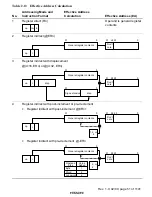
Rev. 1.0, 02/00, page 49 of 1141
(6) Immediate–#xx:8, #xx:16, or #xx:32
The instruction contains 8-bit (#xx:8), 16-bit (#xx:16), or 32-bit (#xx:32) immediate data as an
operand.
The ADDS, SUBS, INC, and DEC instructions contain immediate data implicitly. Some bit
manipulation instructions contain 3-bit immediate data in the instruction code, specifying a bit
number. The TRAPA instruction contains 2-bit immediate data in its instruction code,
specifying a vector address.
(7) Program-Counter Relative–@(d:8, PC) or @(d:16, PC)
This mode is used in the Bcc and BSR instructions. An 8-bit or 16-bit displacement contained
in the instruction is sign-extended and added to the 24-bit PC contents to generate a branch
address. Only the lower 24 bits of this branch address are valid; the upper 8 bits are all
assumed to be 0 (H'00). The PC value to which the displacement is added is the address of the
first byte of the next instruction, so the possible branching range is -126 to +128 bytes (-63 to
+64 words) or -32766 to +32768 bytes (-16383 to +16384 words) from the branch instruction.
The resulting value should be an even number.
(8) Memory Indirect–@@aa:8
This mode can be used by the JMP and JSR instructions. The instruction code contains an 8-
bit absolute address specifying a memory operand. This memory operand contains a branch
address. The upper bits of the absolute address are all assumed to be 0, so the address range is
0 to 255 (H'0000 to H'00FF in normal mode, H'000000 to H'0000FF in advanced mode). In
normal mode the memory operand is a word operand and the branch address is 16 bits long.
In advanced mode the memory operand is a longword operand, the first byte of which is
assumed to be all 0 (H'00).
Note that the first part of the address range is also the exception vector area. For further
details, see section 5, Exception Handling.
(a) Normal Mode*
Note: * Not available for this LSI
(b) Advanced Mode
Branch address
Specified by
@aa:8
Specified by
@aa:8
Reserved
Branch address
Figure 2.14 Branch Address Specification in Memory Indirect Mode















































